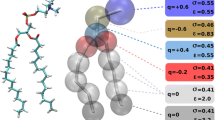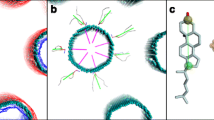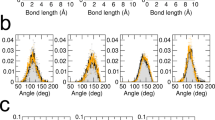Abstract
A multiscale modeling approach is applied for simulations of lipids and lipid assemblies on mesoscale. First, molecular dynamics simulation of initially disordered system of lipid molecules in water within all-atomic model was carried out. On the next stage, structural data obtained from the molecular dynamics (MD) simulation were used to build a coarse-grained (ten sites) lipid model, with effective interaction potentials computed by the inverse Monte Carlo method. Finally, several simulations of the coarse-grained model on longer length- and time-scale were performed, both within Monte Carlo and molecular dynamics simulations: a periodical sample of lipid molecules ordered in bilayer, a free sheet of such bilayer without periodic boundary conditions, formation of vesicle from a plain membrane, process of self-assembly of lipids randomly dispersed in volume. It was shown that the coarse-grained model, developed exclusively from all-atomic simulation data, reproduces well all the basic features of lipids in water solution.









Similar content being viewed by others
References
Feller SE, MacKerell AD (2000) An improved empirical potential energy function for molecular simulations of phospholipids. J Phys Chem B 104:7510–7515
Goetz R, Gompper G, Lipowsky R (1999) Mobility and elasticity of self-assembled membranes. Phys Rev Lett 82:221–224
Kranenburg M, Venturoli M, Smit B (2003) Phase behavior and induced interdigitation in bilayers studied with dissipative particle dynamics. J Phys Chem B 107:11491–11501
Kranenburg M, Nicolas J-P, Smit B (2004) Comparison of mesoscopic phospholipid - water models. Phys Chem Chem Phys 6(16):4142–4151
Lindahl E, Edholm O (2000) Mesoscopic undulations and thickness fluctuations in lipid bilayers from molecular dynamics simulations. Biophys J 79:426–433
Lobaskin V, Lyubartsev AP, Linse P (2001) Effective macroion-macroion potentials in assymmetric electrolytes. Phys Rev E 63:020401
Lowe CP (1999) An alternative approach to dissipative particle dynamics. Europhys Lett 47:145–151
Lyubartsev AP, Laaksonen A (1995) Calculation of effective interaction potentials from radial distribution functions: A reverse Monte Carlo approach. Phys Rev E 52(4):3730–3737
Lyubartsev AP, Laaksonen A (1997) Osmotic and activity coefficients from effective potentials for hydrated ions. Phys Rev E 55(5):5689–5696
Lyubartsev AP, Laaksonen A (1999) Effective potentials for ion – DNA interactions. J Chem Phys 111(24):11207–11215
Lyubartsev AP, Laaksonen A (2000) A general and scalable parallel software package for arbitrary mixtures of molecules. Comput Phys Commun 128:565–589
Lyubartsev AP, Laaksonen A (2004) On the reduction of molecular degrees of freedom in computer simulations. Lect Notes Phys 640:219–244
Marrink SJ, Berendsen HJC (1994) Simulation of water transport through a lipid membrane. J Phys Chem 98:4155–4168
Marrink SJ, Mark AE (2003) Molecular dynamics simulation of the formation, structure, and dynamics of small phospholipid vesicles. J Am Chem Soc 125(49):15233–15242
Marrink SJ, de Vries AH, Mark AE (2004) Coarse grained model for semiquantitative lipid simulations. J Phys Chem B 108:750–760
Martyna GJ, Tuckerman ME, Tobias DJ, Klein ML (1996) Explicit reversible integrators for extended systems dynamics. Mol Phys 87(5):1117–1157
Noguchi H, Takasu M (2001) Self-assembly of amphiphiles into vesicles: a brownian dynamics simulation. Phys Rev E 64:041913
Norberg J, Nilsson L (2003) Advances in biomolecular simulations: methodology and recent applications. Quart Rev Biophys 36:257–306
Patra M, Karttunen M, Hyvönen MT, Falck E, Lindqvist P, Vattulainen I (2003) Molecular dynamics simulations of lipid bilayers: Major artifacts due to truncating electrostatic interactions. Biophys J 84:3636–3645
Reith D, Pütz M, Müller-Plathe F (2003) Deriving effective mesoscale potentials from atomistic simulations. J Comp Chem 24:1624–1636
Shelley JC, Shelley MY, Reeder RC, Bandyopadhyay S, Klein ML (2001) A coarse grained model for phospholipid simulations. J Phys Chem B 105:4464–4470
Soper AK (1996) Empirical potential Monte Carlo simulation of fluid structure. Chem Phys 202:295–306
Stevens MJ (2004) Coarse-grained simulations of lipid bilayers. J Chem Phys 121(23):11942–11948
Sum AK, Faller R, de Pablo JJ (2003) Molecular simulation study of phospholipid bilayers and insights of the interactions with disaccharides. Biophys J 85(5):2830–2844
Tieleman DP, Marrink SJ, Berendsen HJC (1997) A computer perspective of membranes: molecular dynamics studies of lipid bilayer systems. Biochim Biophys Acta 1331:235–270
Tielerman DP, Biggin PC, Smith GR, Sansom MSP (2001) Simulation approaches to ion channel structure–function relationships. Quart Rev Biophys 34:473–561
Toukan K, Rahman A (1985) Molecular dynamics study of atomic motions in water. Phys Rev B 31:2643–2648
Wang W, Donini O, Reyes CM, Kollman PA (2001) Biomolecular simulations: recent developments in force fields, simulations of enzyme catalysis, protein-ligand, protein-protein, and protein-nucleic acid noncovalent interactions. Annu Rev Biophys Biomol Struct 30:211–243
Yamamoto S, Maruyama Y, Hyodo S (2002) Dissipative particle dynamics study of spontaneous vesicle formation of amphiphilic molecules. J Chem Phys 116:5842–5849
Acknowledgements
The author thanks the Center for Parallel Computing (PDC) at the Royal Institute of Technology for granting the use of computer facilities. The work has been supported by the Swedish Research Council (Vetenskapsrådet)
Author information
Authors and Affiliations
Corresponding author
Rights and permissions
About this article
Cite this article
Lyubartsev, A.P. Multiscale modeling of lipids and lipid bilayers. Eur Biophys J 35, 53–61 (2005). https://doi.org/10.1007/s00249-005-0005-y
Received:
Revised:
Accepted:
Published:
Issue Date:
DOI: https://doi.org/10.1007/s00249-005-0005-y




